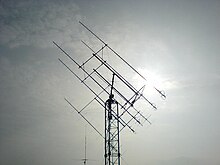SwissCube
| SwissCube | |
|---|---|

|
|
| Type: | Cubesat |
| Country: |
|
| Operator: | various Swiss universities |
| COSPAR-ID : | 2009-051B |
| Mission dates | |
| Dimensions: | 820 grams |
| Size: | Cube with 10 cm edge length |
| Begin: | September 23, 2009, 06:21 UTC |
| Starting place: | Satish Dhawan Space Center , India |
| Launcher: | PSLV C-14 |
| Status: | active |
| Orbit data | |
| Rotation time : | 98.9 min |
| Orbit inclination : | 98.4 ° |
| Apogee height : | 719 km |
| Perigee height : | 710 km |

SwissCube is the name of the first satellite built entirely in Switzerland . It was developed from 2006 to 2007 in a joint project between various Swiss universities based on the Cubesat standard.
The first copy of the satellite (“SwissCube 1”) was launched into space on September 23, 2009 from the Indian rocket base in Sriharikota . It is located in an orbit that runs between 704 and 715 km and has an inclination of 98.4 °. The only 820 gram, cube-shaped satellite with an edge length of 10 cm is intended, among other things, to explore the as yet little-researched phenomenon of the glow of the night sky at a height of around 100 kilometers, the so-called airglow .
Mission objectives
Primary mission
The top priority is to establish a communication system made in Switzerland with a satellite and a ground station. All systems required for this are designed redundantly. After successfully entering orbit, the satellite began communication with the ground stations in Lausanne and Friborg . These transceiver systems are operated in cooperation with the radio amateurs of the Vaud region. The first SwissCube broadcasts under the amateur radio call sign HB9EG on a frequency of 437.505 MHz in the 70 centimeter band .
Secondary mission
In addition, a research mission was carried out to investigate the phenomenon of the airglow effect, the properties of which are still little known. To do this, a special camera in the infrared range observes the phenomenon.
begin
Three identical copies were built:
- The first was launched on September 23, 2009 with an Indian PSLV C14 .
- The second was supposed to be brought into orbit with a Vega mission from ESA, but this did not succeed due to a lack of sponsorship.
- The third is used for testing purposes.
University cooperation
As part of the SwissCube, various universities from the German and French-speaking parts of Switzerland worked together:
- École polytechnique fédérale de Lausanne (EPFL)
- Haute Ecole d'ingenerie et de gestion du canton de vaud
- University of Neuchâtel
- Haute Ecole spécialisée de Suisse occidentale ( Sierre )
- Haute Ecole ARC Ingénierie ( Saint-Imier )
- Ecole d'Ingénieurs et d'Architectes de Friborg
- University of Applied Sciences Northwestern Switzerland ( Windisch )
They paid for the development costs of around 235,000 euros themselves.
Web links
- SwissCube website: swisscube.epfl.ch (English)
- SwissCube: Track it in real time (English)
Individual evidence
- ↑ Railway data according to SWISSCUBE. N2YO, November 3, 2015, accessed November 4, 2015 .
- ↑ SWISSCUBE - satellite information. heavens-above.com, accessed November 4, 2014 .
- ↑ The first Swiss satellite is on its way into space. swissinfo.ch, September 23, 2009, accessed on September 23, 2009 .
- ↑ Hanna Wick: Cube flying in formation: "Cube satellites" are slowly becoming a valuable tool for space travel. NZZ, April 20, 2011, accessed on October 27, 2013 .
- ↑ Alois Feusi: Switzerland has its first satellite. Neue Zürcher Zeitung, September 23, 2009
- ↑ Flieger-Revue February 2009, p. 39, cube for the orbit

